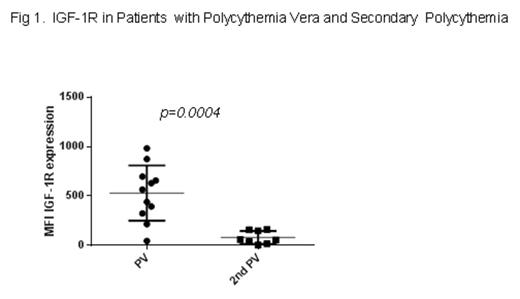Abstract
Endogenous erythroid colony formation in vitro is one of the important criteria for the diagnosis of polycythemia vera (PV). Extensive studies performed in the last decade suggest that IGF-1 plays a significant role in the erythropoiesis and endogenous colony formation in PV. Therefore, IGF-1R signal pathway is important in the pathogenesis of PV. We elected to revisit IGF-1R pathway by flow cytometry technique in PV and other myeolproliferative neoplasms (MPNs). 32 MPN patients (including 11 PV, 19 myelofibrosis (MF), 12 essential thrombocytopenia (ET), 8 secondary PV , and 17 age-matched normal controls were studied. Methods: 1) plasma IGF-1, IGFBP-1, IGFBP-3 were assayed by ELISA(R&D Systems, Minneapolis, MN) ; 2) quantification of IGF-1R . Peripheral blood mononuclear cells (MNC) harvested from Ficoll-Paque separation were stained with phycoerythrin conjugated antibody against IGF-1 receptor (R&D Systems), and assayed by flow cytometry using FACS Calibur system (BD Biosciences, San Jose, CA; 3) quantification of IGF-1R phosphoration (pIGF-1R) after IGF-1 stimulation. MNC cells were suspended in serum-free α-MEM medium for 2 hours, then starved cells were treated with or without 10 nM IGF-1 for 3 min and assayed for pIGF-1R by flow cytometry using Alexa Fluor 647 conjugated antibody against phosphorylated IGF-1 receptor (BD Biosciences); 4) Interferon alpha (IFNα) Treatment. IFN-α (Schering Corporation, Kenilworth, NJ) was added to the cell culture at 100 unit per ml. Cells were incubated with IFN-α for either 2 hours or 3 days and then collected for further pIGF-1R analysis. The results showed 1) No difference in plasma IGF-1 levels in MPN and controls; IGFBP-1 and IGFBP-3 were significantly elevated in MPN than controls but the change of IGFBP-3 in MF patients was not significant. 2) the PV group had significantly elevated IGF-1R expression than secondary PV (Fig 1). Mean ± SE (MFI expression) were 529 ± 84 and 90 ± 30 in PV versus secondary PV, respectively (p=0.004). 3) The untreated PV group had significantly higher IGF-1R than MF, ET, and controls. MF and ET were not different from controls, but 8/19 (43%) in MF and 6/12 (50%) in ET have elevated IGF-1R than controls. 4) No difference in IGF-1R expression in Jak2 (+) versus Jak2 (-) in MPN patients. Mean ± SE (MFI) were 293.2 ± 62.1 and 164.8 ± 47.7 in JAK2(+) versus JAK2 (-) respectively (p=NS). 5) Preliminary studies showed PV has a significant elevated pIGF-1R than controls in unstimulated PB CD34+ cells, but not in MNC cells. 6) IFN-α decreased IGF-1R expression and pIGF-IR about 10% in the PV group.
Conclusions: 1) IGF1R signal pathway is more active in PV than MF, ET and controls. 2) Quantification of IGF-1R expression by flow cytometry may be helpful in differential diagnosis in primary versus secondary PV. 3) IGF-1R expression is not correlated with JAK2 status. 4) IGF-1R phosphorylation is more elevated in unstimulated CD34+ cells of PV patients than in controls suggesting autonomous erythroid colony formation in PV may be associated with IGF-1R activation. 5) interferon-α has some inhibitory effects in IGF-1R expression and phosphorylation but is unlikely to be the main mechanism of its induced remission of JAK2 –mutant allele-burden effects.
No relevant conflicts of interest to declare.
Author notes
Asterisk with author names denotes non-ASH members.


